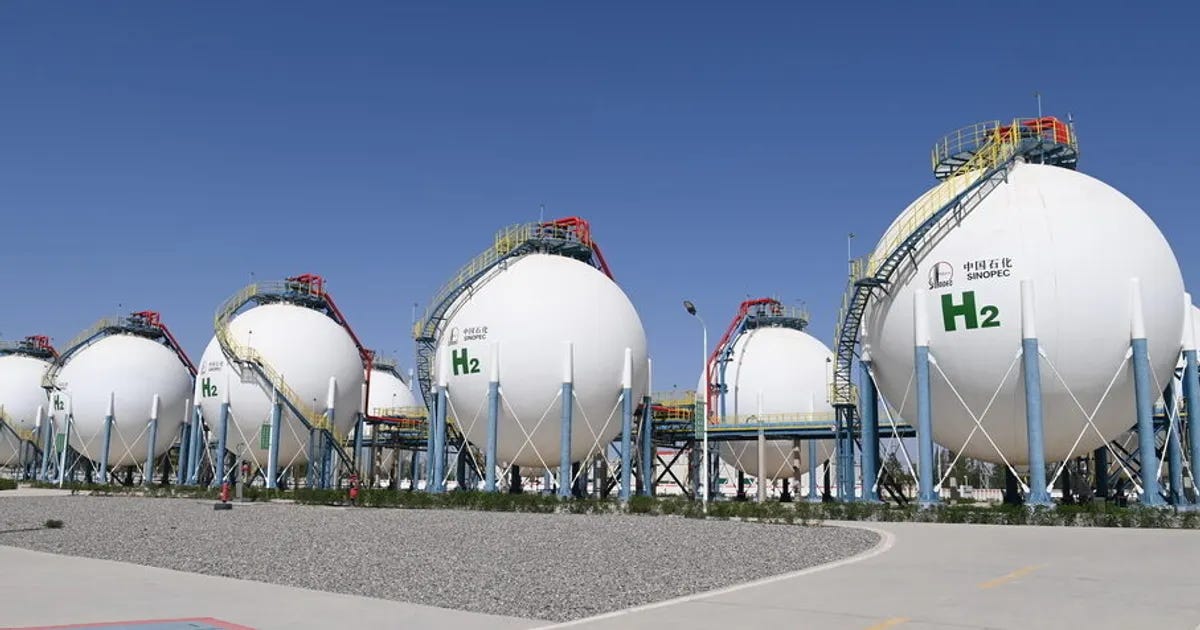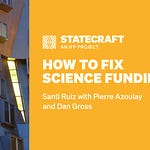Today’s guest is Narayan Subramanian. In the Biden administration, he was a legal advisor, and then an advisor to the Secretary at the Department of Energy (DOE). Later, he was the Director for Energy Transition at the White House National Security Council.
We’ve talked to previous guests about how to ensure government money flows fast and effectively. At the DOE, Subramanian helped ensure that a big influx of money could best be used to support innovative energy projects. If you’ve followed Statecraft a while, you know we’re very interested in how to actually deploy taxpayer dollars most effectively. Narayan played a key role in making sure that DOE could do just that.
Editor’s note: we discuss the DOE’s Loan Programs Office (LPO), which plays a critical role in financing infrastructure that enables new technologies, like nuclear power development and domestic mineral production. DOGE is reportedly pushing for significant cuts in headcount at LPO, which would kneecap its ability to manage existing loans, let alone to underwrite new ones. Without technical staff capacity at LPO of the kind Narayan discusses in our conversation, the federal government risks stalling energy projects that serve national priorities, such as new nuclear energy development for powering AI.
We Discuss:
How the DOE took its modern form
Why don’t tools for funding R&D work for funding deployment?
Does the federal interest in IP stop banks from supporting new tech?
What kinds of technologies can you support with “other transactions authority”?
Thanks to Harry Fletcher-Wood for his edits to the transcript.
[NB: “other transactions authority” is capitalized throughout here for ease of reading, but some sources leave it lowercase.]
Will you give listeners an introduction to what you've been up to over the last four years?
I was a political appointee in the Biden administration. Just minutes after inauguration, I was sworn in to be a legal advisor in the Office of General Counsel [at the Department of Energy]. I was in that role for the first two and a half years of the administration, then I became an advisor to the Secretary, working on implementation for the Bipartisan Infrastructure Law and the Inflation Reduction Act. The last six months of the administration, I was the Director for Energy Transition at the White House National Security Council.
I don't have a great picture in my head of how we went from the Atomic Energy Commission to today's Department of Energy. Will you give us that pocket history?
It’s fascinating history. Everyone knows what the Manhattan Project was. The whole nuclear enterprise in this country was stood up from scratch within a couple of years. The war ends in 1945, and by the spring of 1946, Robert Oppenheimer and others involved with the Manhattan Project started calling for a new apparatus to explore the peaceful uses of atomic energy.
Everyone involved with the project knew that one day this could have spillover effects for other scientific research that could be used for civilian purposes. So the Atomic Energy Act was passed in the summer of 1946, and it established the Atomic Energy Commission, a five-member commission, which Lewis Strauss (of Robert Downey Jr. fame) becomes the chairman of later on. Oppenheimer was one of the scientific advisors to the Atomic Energy Commission. The Commission is not only entrusted with continuing to do the weapons research, but also setting up a whole new function to harness the peaceful purposes for atomic energy, figure out ways to better process uranium, fuel supply, all that stuff.
The decades after World War II are when American consumerism really takes off. Shows like Mad Men, in terms of a cultural moment, are getting at Americans starting to buy more cars, drive more cars, buy household appliances — dishwashers, toaster ovens, you name it. Energy use is exploding. The Atomic Energy Commission exists when that's happening. So, in parallel, the government is putting a lot of money into building nuclear reactors. A lot of the nuclear reactor build-out happens in those decades after the creation of the Commission.
We take all that for granted up until 1973, when the Arab oil embargo happens [The Organization of Arab Petroleum Exporting Countries stopped exporting oil to countries which supported Israel in the Yom Kippur War, including the United States]. President Nixon immediately jumps in and gives an Oval Office address saying, “This is serious and we need to treat this like we're almost at war.” You have all these images from that period, the long gas lines. Nixon calls immediately for a “Project Independence.” He starts talking about how we need to figure out a way to address our dependence on foreign oil.
That Oval Office address basically says, “We've done big things before and we have to treat this crisis with the same seriousness we did when we undertook the Manhattan Project and the Apollo mission.” It's a really incredible speech.
Within a month, there is a new executive order establishing a Federal Energy Office. A few months after that, Congress formally establishes the Federal Energy Administration under the Federal Energy Act. Congress knows we really need to set up a new apparatus that's not just doing R&D [research and development], but has the ability to scale up new energy technologies and do it very quickly.
When you go back to the statute that established the Atomic Energy Commission, you'll see a lot of references to the need to bring in private enterprise and for the government to collaborate with private enterprise. In the last few years, you've probably heard a lot of folks at the Department of Energy — Secretary Granholm, Jigar Shah, David Crane — use phrases like, “The energy transition must be private sector-led, government-enabled.” That's been at the core of energy policy in this country for decades.
Industrial policy and energy policy have been intertwined for the last 100 years, going back before the war to the Federal Power Commission. By the fall of 1974, we're a year out from the Arab oil embargo, President Nixon resigns, President Ford takes over. One of his first speeches is to the World Energy Conference in Detroit, and he again invokes this concept of Project Independence. He talks about the Apollo mission and the Manhattan Project and says, “We really need a new agency to be able to deal with this crisis.” Gas prices are so high, the supply shortage is still real. Americans are still hurting. There was a really good book called Panic at the Pump that chronicles this by Meg Jacobs, a Princeton historian. She has quotes about how when the Arab oil embargo took effect, the feeling that Americans had was as if bombs had dropped. There was almost this metaphoric silence across the country, because we had become so dependent on oil. When you talk to people who lived through those times, they'll tell you, "I remember waiting hours in a gas line.” So this is very palpable; it had fully taken up all of the political space.
So it's not a coincidence that President Ford felt the need to focus on energy pretty quickly. Within a few months of taking office, he signs the Energy Reorganization Act of 1974 into law. That establishes the Energy Research and Development Administration. They consolidate all of the non-nuclear energy R&D functions that are scattered across the National Science Foundation and the Department of Interior together under ERDA, as it was known. They knew that ERDA was not going to immediately serve all the needs, but it is a significant step to consolidate energy functions: not just atomic energy, but everything. That clearly was not enough, and a couple of years later, President Jimmy Carter wins election, and his famous "We're in the moral equivalent of war” speech lays out a vision for a new Department of Energy. He pushes that into motion pretty quickly.
To paint with a broad brush, the Department of Energy is this weird creature that has a bunch of nuclear energy research and security work, the national labs, and all this other infrastructure and energy stuff going on. Why does it end up being this three-legged stool?
A three-legged stool is an excellent way to put it, and maybe I would add a fourth leg in the last couple of years. As of October 1977, when the DOE Organization Act was passed, this enterprise will continue working on nuclear weapons. There's also a nuclear cleanup mission, which continues today. It's a significant part of the department's budget. And then we really have to expand our R&D enterprise. Even back then, there was a fourth leg to the stool, which was figuring out how to scale up these technologies and commercialize them.
You'll see, sprinkled throughout the DOE Organization Act, all these references to, “This department is meant to have broad authority to address the energy needs of the country.” You'll also see the reference to private enterprise. I don't think they use the word “commercialization” per se, but they say, “This department is entrusted with the duty to figure out how to get things out of the lab and into the real world.”
That was at the core of the department when it was founded in 1977. Then you have two bills that passed pretty quickly after that. The first is the National Energy Act of 1978. My favorite is the Energy Security Act of 1980, which was passed in June of an election year. If one could do an alternative history of US energy policy, I would focus on that act, because it authorized an $88 billion Synthetic Fuels Corporation, a Solar Bank [to support the building of solar power], geothermal research, and the Renewable Energy Resources Act.
After Jimmy Carter lost the election in 1980, one of the first things during the Reagan transition was to dismantle the Department of Energy and dismantle the Energy Security Act of 1980, so it ends up being a bill that goes unfulfilled. And this has importance for our conversation today, because in the 1980s there were multiple attempts to shut DOE down as an agency. DOE ends up in this defensive crouch where it goes back to doing R&D, nuclear weapons work and nuclear cleanup through the ‘80s and ‘90s, all the way until the early 2000s. Until the Energy Policy Act of 2005, there weren't very serious efforts to get DOE to go back to trying to scale up and commercialize energy technologies.
The Energy Policy Act is when the DOE Loan Programs Office [supporting clean energy projects] is first authorized. That same year, ARPA-E gets set up [the Advanced Research Projects Agency - Energy, which supports energy research]. It’s the DOE version of DARPA [the Defence Advanced Research Projects Agency; Statecraft previously spoke to Dr. Joshua Elliott, a former Program Manager at DARPA]. This is before the fracking revolution took hold. We were starting to get nervous again about our dependence on foreign oil. You've got all these things leading up to the financial crisis, and then the Obama administration passed the Recovery Act in 2009, and that plunges a lot of money into trying to deploy energy, and into R&D work.
The whole mission at that time was to get money out the door to “shovel-ready” projects. There wasn’t much time for the department to think creatively, or look at its authorities and put money out the door in innovative ways. It was like, “We gotta get money out the door yesterday.” Fast forward to when the Bipartisan Infrastructure Law passes in November 2021 and the Inflation Reduction Act passes in the summer of 2022. That's the first time the DOE gets a huge influx of money and the ability to think about how to put this money out in the most innovative, catalytic way.
So you end up in the Biden administration at the DOE, as it’s trying to move a huge amount of money for Biden admin priorities. Will you just say a little bit about how the DOE is structured at that point? What tools do you have to move that money out the door?
This was a very live conversation at the time. DOE was still organizationally set up to largely be an R&D enterprise when we came in in January 2021. But in anticipation of one or both of these bills being passed, there was a lot of work done before and during the transition on trying to reorganize DOE to exercise more of a “demonstration and deployment function” and not just an R&D function.
What’s the difference between an R&D function and a deployment function?
R&D: the government is paying you, potentially, to fail. The government is fine with you taking risks with your projects. It can be an innovative sodium-ion battery. Maybe it hasn't been proven at scale yet, it's still being tested out in the lab and the government is giving out a couple million dollars of grant money for that. You're being paid under a cost reimbursement structure. Regardless of the outcomes of your research, you're getting paid to try.
And you basically submit a receipt – “Here are the costs for the project” – and if they’re within scope, DOE pays them back, and that’s it.
More or less, yeah. I'm oversimplifying, but that's essentially what it is. So then when you think about demonstration scale, a project could run upwards of a billion dollars: at that stage, the government's not just trying to pay you to fail. They want to make sure that your technology is proven and has a higher chance of success. They're not just throwing grant money at a highly risky project. The government is going to still take risks that the private sector isn't. That's the whole reason why it’s giving that grant money. By the time President Biden was sworn into office, the Energy Act of 2020 had been passed. It was a bipartisan bill in the waning days of the Trump administration, authorizing the Office of Clean Energy Demonstrations. So there was already this vision that government needs to be putting more money into scaling up technologies at the demonstration level.
Deployment is, once you've scaled up that technology and it's been demonstrated, then you want to deploy the second, third, fourth, fifth, n-th of that project. At that point, you've reached commercialization for that technology. The demonstration and deployment function requires a very different skill set. It requires not just technical experts, but also prototyping, and people that have worked in finance. You've reached success for energy technology when you can finance that project. That means you have an offtaker.
Will you define “offtaker”? I did not know what an offtake agreement was before this job.
An offtake agreement is quite literally what it sounds like. I'm selling this thing: it could be batteries or electricity itself. Someone is saying “I will buy X amount of those things for Y price.” That offtake agreement allows one to go to a bank and say, “Over the next 10 years, if I build this thing, and I produce these widgets, or electricity, I'm getting paid this much.” The bank is very conservative, and that's why if you're getting debt for a project, it has to be “technically de-risked” by that point. There might still be some financial risk — that's why you're signing these offtake agreements. A bank is only going to give you a loan at that point. That's how you reach the final investment decision for a project, then the project eventually gets built, and voila.
You come into the DOE where the mandate has just come from Congress: Do more demonstrations. A year or two later, you get this push from the Biden admin and the infrastructure law to do more of the deployment work. Did you need to bring a lot of talent in? What did the reorg look like?
The Loan Programs Office (LPO) had existed for a decade by that point. But they hadn't executed any new loans in years.
Was that hesitation a consequence of the Solyndra blowup?
One could say so. There’s many reasons. The Energy Act of 2020 started laying the groundwork for the LPO to be reinvigorated as an enterprise within the department. As soon as the new administration gets in place, negotiations start for the “Build Back Better” agenda, which eventually gets broken up, on the energy side, into the Bipartisan Infrastructure Law, which further amended some of the authorities, and then the Inflation Reduction Act, which gave LPO significantly more loan authority, upwards of $400 billion. There is a recognition that if one or both of these bills get passed, we're going to need a lot more expertise on the demonstration and deployment side.
To give you a concrete example of how the department was not set up immediately to take this on, there's a little quirk in how the grant structure works at the Department of Energy. If the department gives you a grant for a project, it has a property interest in that project, pretty much in perpetuity, until the property or the equipment diminishes in value under $7,500 — which is not a big deal for a small lab project. But if you're trying to build something big, and you go to a bank and say, “The government might have a running interest,” the first question a bank is going to ask is, “Am I going to be fighting DOE in bankruptcy court for pennies on the dollar if this project fails?” You're scaring a bank away from wanting to invest in or provide a loan for one of those projects.
Because they know that in many situations, they’ll be directly rivaled by the federal government.
This had been corrected for nuclear and fossil energy projects. A lot of the way federal agencies are set up is, there's a lot of gum and tape along the way. Congress plugs a hole in a leaking ship, or adds a little thing to the top. When we were getting ready to implement the Bipartisan Infrastructure Law and the Inflation Reduction Act, it became clear that this is going to be a huge problem.
If you look at the Consolidated Appropriations Act of 2023 [which authorises government spending], which passed in December 2022, just a couple of months after the Inflation Reduction Act, there is authority for the Secretary of Energy to vest title in any projects undertaken for demonstration or deployment purposes. That means the Secretary of Energy can say, “At the end of this project, there's no running government property interest.”
The logic behind why the government should have this running property interest made sense in the very beginning, which was, “We want to make sure that you're not wasting taxpayer money.” But the reality is, the government is not trying to recover pennies on the dollar for a failed project. What the government cares about is what happens to the IP [intellectual property] associated with that project. You don't want that IP to be bought up and taken overseas. That had happened for decades. There wasn't good enforcement of the IP rights of the government.
Imagine a world in which the government can reach an agreement with the counterparty. In this case, it will be the developer of the clean energy technology and their bank, perhaps saying, “At the end of this project, we will vest title. The only thing we care about is, if this project gets sold, making sure the IP is not going overseas or to a certain country.” It's a lot more complicated than that, but conceptually, that's how simple it is.
But even getting to that, structuring award terms to ensure that a private bank feels comfortable giving a loan to one of those projects, requires very different thinking than what the DOE had. This is precisely why the Undersecretary for Infrastructure was set up at the Department of Energy, and a bunch of new offices were created: like the Office of Clean Energy Demonstrations, a new Office of Manufacturing and Energy Supply Chains, a new Office of Grid Deployment Office, and then the existing Loan Programs Office. These offices were consolidated under a new Undersecretary for Infrastructure, and led by David Crane and Leslie Biddle, the Deputy Undersecretary, who came with a very strong finance background.
Being charitable, DOE didn't have that scale of grant money to put out until the Infrastructure Bill and the Inflation Reduction Act passed. For example, just for batteries and critical minerals, the Department of Energy was giving out $6 billion of grant money. That was unprecedented. They had not flexed that muscle before. Even during the Recovery Act, it was a very different posture. It was smaller projects and money out the door yesterday. It was a lot of money given to states directly to set up revolving loan funds for energy retrofits. This was supposed to be, “Let's be deliberate about how we re-industrialize parts of the economy, make long-term investments in our infrastructure, and set up the United States to succeed in the clean energy race of the future.”
You’re very good at articulating the broad Biden admin agenda, but let me ask you about this incredibly arcane, little, weird detail that you worked on. You spent a lot of time writing a guide to using Other Transactions Authority (OTA) [Statecraft previously talked to Rick Dunn about the power of OTA at DARPA.] It sounds like a nightmare. You write this hundred-page document on contracting and contracting authorities. What's the point of going into the weeds and fixing that?
We were at an unprecedented moment, on the heels of the Bipartisan Infrastructure Law being passed. Just that one bill gave DOE about $65 billion of new grant money to put out of the door. We set up the Undersecretary for Infrastructure, and in the general counsel’s office, I was involved in writing the memo to figure out how to disburse that money. It became clear that we were going to have to think about contracting very differently.
A lot of voices had been calling for the Department of Energy to exercise Other Transactions Authority. People in government contracting have this mythology about “Other Transactions.” Put simply, Other Transactions are defined by what they're not: they're not a traditional grant or cooperative agreement. That's not a very fulfilling response, but when you are executing a grant or a cooperative agreement as the government, there are a lot of clear rules around what the terms of the contract can be under 2 CFR 200 [the document stating administrative and audit requirements], and then each agency has its own regulations.
Now, a lot of good comes out of that. Not all government contracting is rickety and inefficient. One reason the regulations are good is they lessen the space for negotiation for contracts. As the government — and especially when you're doing business with the government — you don't want to be spending years negotiating a grant contract.
Also, those rules are in place to prevent waste, fraud, and abuse. As much as people want the government to be big, bold, boisterous, take risks: the government is held to a very different standard than the private sector. The private sector has the luxury to fail, and failure is seen as a good thing. When the government fails, it very often becomes a political football with oversight hearings. The contracting structure is a response to that, to ensure that the opportunities for fraud, waste, and abuse are minimized. There are cost accounting standards and standards attached. “If you're paid for potential failure, let's make sure that you still tried just enough.” There's very clear rules around the IP rights that the government takes.
These are all very good things. But most of those regulations were written with R&D contracts in mind. Typically, when the government is putting money out the door, you can roughly bucket it in two categories: either the government is procuring something, paying someone for anything from chairs to a warfighter, or the government is providing financial assistance. Either the federal government is buying something, or it’s supporting you in doing some project. Loans are slightly different: they don’t fall under the same regulations, so let’s set them aside.
DOE was very quick to say, "We've done ‘cooperative agreements’ for big carbon capture and storage projects and nuclear projects in the past. We should do that again.” Cooperative agreements have the standard cost accounting standards attached, the cost performance structure, and IP terms are clearly laid out. But all of these contracts envision having a single counterparty that's just doing one thing [that is, a contract between government and one provider]. Once you get to the demonstration and deployment phase, where you're potentially trying to help seed or create a market, you have this developer that's building or scaling up the energy technology, they've got potential offtakers, you've got a whole supply chain around it. The government may be contracting with the consortium. It's not just one entity, it's multiple entities.
Cooperative agreements could still work, but we realized pretty quickly it could be quite limiting. At times, the government is not just executing a procurement or a financial assistance function. For example, the Department of Energy recognized through its hydrogen liftoff reports that we've got a problem setting up a new hydrogen industry where there's not a clear strike price for clean hydrogen. We're trying to seed a new commodity market and there's a stalemate: No one wants to pay a price premium for this just yet, and no one knows what price to sell it at just yet. There was a need for the DOE to come in and provide demand-side support for a few projects and try to enable some market transparency.
The other thing with these offtake agreements is, often they don’t publicize how much someone is paying for something. So it's very hard to have market transparency and build a whole ecosystem. Whereas when the government is involved, they can say, “If you're getting government money, one of the conditions is you're going to publish how much you're selling this for, because we're trying to catalyze the market.” So it became clear that we needed to look at our contracting apparatus and see, is there a way to invigorate our use of Other Transactions Authority?
Why was it so important to have another tool to do the contracts? What did you want to be able to do?
You don't know what you don't know. You don't know what challenges are going to arise when you're negotiating a contract. A program office like the Office of Clean Energy Demonstrations or any manufacturing energy supply chain office may go in saying, “We're trying to catalyze this market, or we're trying to contract with multiple players under one award.” You want to make sure your contract is fit for purpose. But when we undertook this effort, what I was really getting at is, this should be a tool in our toolbox — it currently does not exist. Especially if you're contracting with entities you haven't contracted with before, you don't know what they want in the contract. If you don't have the flexibility to think through that contract offer, you won't be able to come to a deal.
The flip side of this is, OTs can't be a hammer in search of a nail. Another way people describe an Other Transaction agreement is that you can literally take a blank sheet of paper and write a contract. That's something that government is not used to doing. You have preset contracts.
Whereas you and I, as private citizens, can contract basically any way we want.
Right. But what became clear was that DOE definitely had Other Transactions Authority, going back to at least 2005. In the Energy Policy Act of 2005, you can tell if you read the statute that Congress was so frustrated with DOE and the way it contracted, because Congress cross-referenced DOD’s [the Department of Defense’s] Other Transactions Authority, and said, “DOE, you now have this OTA. By the way, you've got 90 days to promulgate regulations to implement this ‘Other Transactions Authority.’” That’s Congress saying, “Get your rear in gear.”
What was that in response to? Was Congress just saying, “The contracts that DOE currently writes are not fit for purpose”?
Yeah, essentially. You can tell Congress is impatient, and had gotten increasingly impatient, because new grant programs were stood up where Congress explicitly said they should use a milestone-based Other Transaction. So — the Fusion Milestone Program that the Office of Science at the Department of Energy administers — the Energy Act of 2020 authorized that program and explicitly says “DOE should do this as an Other Transaction.”
And a “milestone-based contract” is when you get paid as you meet certain technological thresholds. If you can build a technology that does this and that, you get the big chunk of money, and then we move on to the next phase.
The famous example of this is the SpaceX agreement that NASA entered into in 2006. It's the gold standard for milestone-based contracts. It's different from cost-based reimbursement, because with that, you're being paid for trying. With a milestone-based payment, if you don't hit this technical milestone, you're not going to get paid. That's a great deal for the taxpayer. You're paying for success, but it also helps push private industry to try their best and succeed.
There's another contract structure in between, which is a fixed-cost agreement: regardless of how you get to Point B, as long as you get there, we'll pay you — So you're incentivized to do it as cheaply as possible, so you can pocket the difference. That's paying a private enterprise to be as efficient as possible. That's another flavor of Other Transactions that DOD was very used to.
So DOD and NASA do Other Transactions. Since 2005, the Department of Energy has had this authority. What was going on in the 15 years between then and 2020, that it hadn't built the muscle of doing Other Transactions?
There's a great GAO [Government Accountability Office] report from 2016 that did a comparative study of all the agencies. Between 2011 and 2014, DOE did fewer than 20 OT agreements. NASA had done probably about 10,000 and DOD was somewhere in between, but DOE was not using it. When we started looking at this, there were only one or two people across the entire Department that were warranted to execute an Other Transaction agreement.
That is, DOE has the authority, but within DOE…
You have that contracts officer that is actually writing and signing the contract on behalf of DOE. You need to be “warranted” in order to execute an Other Transaction agreement. There were just a small handful of people and very little institutional knowledge on how to do that.
Credit to the deep institutional knowledge and the civil servants at DOE. There is a really incredible group of folks that have done almost every flavor of contract you can imagine within the existing structures, that have also always wanted to explore the use of OTs. But there were a couple of bumps in the road. One, 2005: Congress passes the Energy Policy Act, and DOE, in response to that 90-day shot clock, they copy-paste DOD’s regulations. I say this very loosely, it's not exactly a copy-paste. But they largely model these regulations after those.
Those regulations enable the use of “Technology Investment Agreements” (TIAs). This is what the fixed-cost agreement is. DOD had set up TIAs, largely for prototyping and very DOD-specific activities. It's not a good fit when you're trying to commercialize energy technologies and seed new markets. You're trying to take a widget, prototype it, then scale it up, but you don't get the full bang if you just use the TIA flavor of that authority Congress had cross-referenced. Then the prevailing wisdom within the Office of General Counsel was that this authority is not super-expansive. It did, however, expand DOE's ability to offer more IP flexibility. People recognized that, but again, the regulations were limiting. So DOE hadn't touched this regulation in nearly 20 years.
So you're in the general counsel's office at the Department of Energy, and you do what?
August 16th, 2022 — I remember the exact dates because this was somewhat intentional — the Inflation Reduction Act gets signed into law by President Biden. August 17th, our Chief of Staff at DOE kicks off an innovative funding mechanisms working group, which I co-chaired. We pulled together an incredible, cross-cutting team across the DOE enterprise. The way DOE is set up, you've got DOE headquarters and field offices all across the country: in Golden, Colorado, in Idaho, in Pennsylvania and West Virginia, in Chicago. A lot of the contracting functions happen through the field offices. We pulled in the best of the best from headquarters and the field, and set up an advisory council of the heads of each program office as well.
At the outset, we said, “We know, because of the Bipartisan Infrastructure Law and the Inflation Reduction Act, you all will be trying to do creative things contracting-wise. So we're going to take a second look at our Other Transactions Authority as DOE.”
A lot of this work was done by the best of the best career civil servants. A couple of things have to fall in place for an effort like this to happen. You need to bring your best institutional experience, people who know how the contracting system works in the department. But one of the amazing things that happened at DOE over the last few years was — as a result of setting up the Undersecretary for Infrastructure and bringing in a lot more commercialization thinking into the department — you had this whole new cadre of folks that came in from the private sector. They were trying to think in terms of commercial contracts. So you have this perfect tension where people wanted to rip up the contracting structure as we knew it, but they knew exactly why they wanted to do it.
Then you had people in the General Counsel's Office and in the contracting apparatus that knew the limits. What you got through this effort was — I don't want to say a compromise solution — but we got to the end goal of figuring out how to reinvigorate our Other Transactions Authority in a way that could serve the larger purpose.
I'm painting with a broad brush here, but a lot of the people who came in had Wall Street and private sector experience, doing the project finance stuff that DOE was being asked to do. Their impression was, “If we were doing this in the private sector, we'd structure the contract this way. Doesn't look like we have that flexibility here. Best practice out there is to contract this. But I literally cannot do this, because the cooperative agreement structure doesn't let me do it.”
Even though, if I were at Goldman Sachs doing this project finance agreement, we'd do this in a flash.
Yeah. We also didn't just settle for looking back at the 2005 Other Transactions Authority we had. I want to give a shout out to one of your previous guests on the show, Rick Dunn [the godfather of Other Transactions Authority]. He has been highly critical of all agencies, but he's had special ire for DOE, saying that DOE had never exercised its “organic other transactions authority.”
I had many conversations with Rick Dunn. One of the things that was generally believed within DOE was that DOE does not have the same Other Transactions Authority as NASA, because there's a one-word difference in our statutes:
The NASA statute: "The secretary has the authority to enter into grants, leases, cooperative agreements, and other transactions.”
The DOE Organization Act of 1977 had language along the lines of: “The Secretary has the authority to enter into grants, contracts, leases, cooperative agreements, and other similar transactions.”
This word “similar” was different. It's not “other transactions,” it's “other similar transactions.” For years and years, everyone would say there is a clear distinction, and that therefore DOE does not have NASA's authority. We agonized over this.
Part of this working group was that people were so energized to look at the legislative history. In the committee hearings [for the DOE Organisation Act of 1977], there's this incredible quote from John Dingell, the Chairman of the Energy and Commerce Committee in April 1977. In many ways, you could call him the father of the Department of Energy. He had envisioned this department to be the solution to the energy crisis. Dingell says in the hearing,
“Observe, Mr. Chairman, the great breadth of authority that the Secretary gets. He may enter into and perform contracts, leases, and grants. You have cooperative agreements and other transactions with public agencies and private organizations and persons. He can do literally almost anything he wants to in terms of expending money and making agreements. That is very, very broad authority.”
You've got that, and you've even got a concurrence from the minority in the committee hearing. They very closely modeled this after the Space Act [authorizing NASA]. That's also clear in the committee hearings.
This leads us to put together a memo, which the general counsel Sam Walsh signs the summer of 2023, saying, “Actually, DOE does have this broad Other Transactions Authority from its inception.” It's not just this one quote from the committee hearing. When you look at the historical context, DOE was set up to be a wartime agency. We were considered to be in a wartime footing in the midst of the energy crises. You look at all these different quotes in the Organization Act that say, “There's a grave energy crisis and DOE is meant to help solve this.” When you're setting up a new agency, you don't know what that agency is going to have to undertake one day, which is why you entrust it with broad authority like this.
So what did you do with that revised Other Transactions Authority guidance?
The first thing you saw is this demand-side support for hydrogen. The Office of Clean Energy Demonstrations put out a solicitation for an independent entity to help potentially provide contract for differences [which fix a price, reducing the risk providers face] and help seed a new hydrogen market. In their solicitation, they explicitly said “We will enter into agreements pursuant to 42 U.S.C. 7256 A.” That is the line of the original DOE Organization Act, the Other Transactions Authority that I mentioned that's cross-referenced to DOD’s. That's 7256 G. These authorities work very well together because the Subsection G authority provides broader IP flexibility. The Subsection A authority provides broad flexibility for everything that's not IP. In January of this year, DOE finally also updated the original OT regulations from 2006. So that was almost 20 years in the making. That was the Technology Investment Agreement (TIA) that came under the regulations from 2006. DOE updated that to say, "We're not limited by what DOD was doing any more. Our IP flexibility is broader. And, we have this broader original Other Transactions Authority.”
Similarly, in a recent solicitation for Gen III+ nuclear reactors, the Office of Clean Energy Demonstrations put out a solicitation saying, “We're going to enter into two contracts, at least, that are Other Transactions contracts.” This is because we're not just contracting with the developer. We're contracting also with the developer and a potential offtaker or fuel supplier as well. Recognizing that there may be multiple stages of this grant agreement and there may be different entities that join this team, there's a need for Other Transactions Authority because we're going to have to develop a pretty bespoke contract.
In that case, it’s because we’re looking for new nuclear reactor models and you want to be able to catalyze that industry?
One of the problems in the nuclear industry is filling out the order book for that reactor. Also, making sure that you have offtake agreements. You have this chicken and egg problem: no one wants to buy the electricity without knowing what the price is going to be, but no one wants to build the thing without knowing what people are going to buy the electricity for. DOE as an agency can help catalyze and smooth that.
If you could go back into the Department of Energy, knowing what you know now, and run through that playbook again, what would you have done differently? Would you have tried to start the OTA working group earlier?
I wish we had kicked off the innovative funding mechanisms working group even sooner. That being said, institutional change generally takes time. Among the things that came out of this effort: we put this OT Guide out publicly, because the idea was not just to change the zeitgeist within the DOE, but also to make sure that everyone outside knows we're open for business now to do Other Transactions. “If you do funky interesting stuff we couldn’t contract you for before, talk to us.”
We set up a whole training program within the department. So this comes back to state capacity. You have to build that muscle within the department. I do wish we had started perhaps even a year earlier, but I didn't even know what OTs could unlock in 2021. There'd been a lot of talk about OTs, but it felt very loose. You didn't know what the use case could be until people were seriously discussing what the Bipartisan Infrastructure Law programs could do, or what eventually the Inflation Reduction Act programs could do. Also, we were deep in the throes of negotiations and providing technical assistance to the drafting of the Bipartisan Infrastructure Law and the Inflation Reduction Act.
Let's say Dems are back in the White House in 2029, and you have this bevy of tools at the Department of Energy. What do you want to see? What kinds of contracts do you want to see made then?
I would say even earlier, it doesn't matter Democrat or Republican, even this administration. Energy Secretary Chris Wright is a supporter of nuclear and geothermal energy. These are programs DOE still has significant grant dollars in to help catalyze these industries. The Department of Energy today can continue to take advantage of OT authority.
Looking out to 2029, I think there can be a lot more innovative program design. For the foreseeable future in the clean energy space, you're going to have a lot of market formation challenges, especially in the face of cheap, clean energy products coming in from other countries. There is a need for industrial policy to help stand up and catalyze industries. Other Transactions Authority lets you be more nimble as a government agency.
I do want to emphasize, just because you have OT authority, it doesn't mean there's no guardrails at all. The reason we wrote all this internal guidance as well is to ensure that there's still guardrails. In fact, we even briefed the Inspector General's Office right after this effort ended to make sure that they were fully aware of what we were opening up. We set up all these processes to make sure that there were checks and balances. That being said, there's a fine balance. You don't want OTs to become the new cooperative agreement, that eventually there's only three ways of doing an OT. That defeats the purpose, as Rick Dunn would say.














